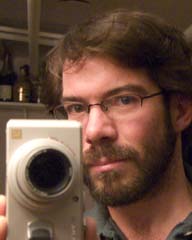Therkelsen Takes up Environmental Postdoc
 In 2010 Jes Therkelsen begins a two-year residency on campus, teaching and experimenting with how scientists can use visual communication to better publicize their work. This fall he will teach an undergraduate class in video production and visual communication as well as meet with faculty and students to begin exploring the potential for joint projects.
In 2010 Jes Therkelsen begins a two-year residency on campus, teaching and experimenting with how scientists can use visual communication to better publicize their work. This fall he will teach an undergraduate class in video production and visual communication as well as meet with faculty and students to begin exploring the potential for joint projects.
The environment postdoc position caps a decade-long effort to build a nationally competitive undergraduate program in environmental science and policy. Appointments rotate across the sciences, social sciences, and humanities, integrating all aspects of Arts & Sciences into the program. The initiative is funded partly by the Andrew W. Mellon Foundation; and partly by donors who are helping to complete the matching requirement.
Yuehan Lu, the program’s first postdoc, was in residence 2008-10 and worked with students to research estuary areas of the York River. Chris Marcoux, appointed for 2009-11, is working with professors and students at the College’s AidData project with a research focus on the distribution of international environmental aid.
"This is a new frontier in undergraduate education and research," according to John Swaddle, director of the program in Environmental Science and Policy. "We are very excited that Jes can be the catalyst for all kinds of new collaborations on campus."
"Traditionally scientists have not had a good track record of effectively communicating their work to the general public or to decision-makers, at all levels of government," said Swaddle. "Our undergraduates will not only have scientific expertise but also be stellar communicators, aware that active dissemination of ideas is just as important as the research that generated those ideas to begin with."
{{youtube:medium:center|6BO3cuUJDaM, "Environmental Film Maker in Residence"}}
Therkelsen holds degrees in both geology and film, a cross-disciplinary background he finds "wholly congruent" with the holistic nature of environmental study. He is affiliated with American University, Catholic University, and the Arts Institute of Washington, D.C., and is a founding director of Sensory Media Arts LLC, a media production company. In 2010 he was awarded a Young Artist Grant from the D.C. Commission on the Arts and Humanities.
Why Video, Why Now?
The evolution of visual communication has brought us to a point where it's relatively easy and inexpensive to produce a video, and practically free to distribute it through YouTube, websites, and other electronic venues.
"The model used to be making full-length film documentaries, which were then shopped around at film festivals," noted Therkelsen. "Now that the making and distributing of videos is affordable and widely available, we see all kinds of new possibilities. How can we use the new media to tell the stories of science? How can we cut through the information overload to find the right audiences and get the scientific knowledge to them?"
Through effective use of video, scientists can communicate directly with their audiences, without intervening filters that can introduce errors or bias – and explain their work in ways that are easily understood.
“I believe the best science only goes as far as it’s communicated. My work here is a great opportunity to show that to a rising generation of students.”














